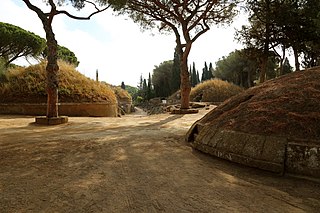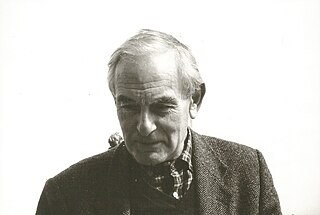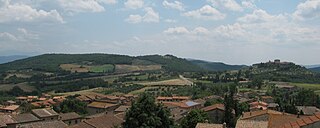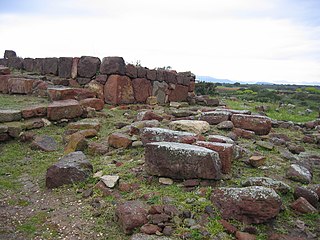
Cerveteri is a comune (municipality) in the Metropolitan City of Rome Capital, in the Italian region of Lazio. Known by the ancient Romans as Caere, and previously by the Etruscans as Caisra or Cisra, and as Agylla by the Greeks, its modern name derives from Caere Vetus used in the 13th century to distinguish it from Caere Novum.
Giovanni Becatti was an Italian Classical art historian and archaeologist.
Mario Torelli was an Italian scholar of Italic archaeology and the culture of the Etruscans. He taught at the University of Perugia.

Massimo Pallottino was an Italian archaeologist specializing in Etruscan civilization and art.

Italo Gismondi was an Italian archaeologist. He is most famed for Il Plastico, a massive scale model of imperial Rome under Constantine the Great.

Lucos Cozza was an Italian Roman archaeologist.

San Giovenale is the modern name of the location of an ancient Etruscan settlement close to the modern village of Blera, Italy. The main settlement consists of high plateau split in two parts, normally referred to as the Acropolis and the Borgo. The settlement is surrounded by a number of burial sites. The excavations of the settlement were divided into eight areas: Areas A-F on the Acropolis, the Borgo and the Bridge over the Pietrisco.
Nancy Thomson de Grummond is the M. Lynette Thompson Professor of Classics and Distinguished Research Professor at Florida State University. She specializes in Etruscan, Hellenistic and Roman archaeology. She serves as the director of archaeological excavations at Cetamura del Chianti in Tuscany, Italy. Her current research relates to Etruscan and Roman religion, myth and iconography.

Louise (L) Lidströmer is a Swedish artist who studied at the Royal Swedish Academy of Arts in Stockholm 1967–72. She works with paintings, sculpture and object installation, and has presented large series of exhibitions in and outside Sweden.

Acquarossa or Fosso Acqua Rossa is the modern name of the location of an ancient Etruscan settlement abandoned or destroyed in the second half of the sixth century BC. Located near Viterbo, in Etruria, was excavated by the Swedish Institute at Rome in the 1960s and 1970s. An elite complex similar to the Regia in Rome was excavated at the site.
Paul Åström was a Swedish archaeologist and classical scholar. He was a professor at the University of Gothenburg and director of the Swedish institutes in Athens and Rome. He is mostly known for his achievements in the prehistoric archaeology of Cyprus.

Poggio Civitate is a hill in the commune of Murlo, Siena, Italy and the location of an ancient settlement of the Etruscan civilization. It was discovered in 1920, and excavations began in 1966 and have uncovered substantial traces of activity in the Orientalizing and Archaic periods as well as some material from both earlier and later periods.
Poggio Colla is an Etruscan archaeological site located near the town of Vicchio in Tuscany, Italy.
Örjan Wikander is a Swedish classical archaeologist and ancient historian. His main interests are ancient water technology, ancient roof terracottas, Roman social history, Etruscan archaeology and epigraphy.
Francesca Romana Serra Ridgway was a leading twentieth century scholar of Etruscan and Italic archaeology.

Monte Sirai is an archaeological site near Carbonia, in the province of South Sardinia, Sardinia, Italy. It is a settlement built at the top of a hill by the Phoenicians of Sulci. The history of studies in Monte Sirai has a very precise date: the fall of 1962, when a local boy casually found a female figure carved on a stele of the tophet. Following further inspections, in August 1963, the local Soprintendenza and the Institute of Near Eastern Studies of the Sapienza University of Rome started excavations, leading to a fairly comprehensive study of the entire town.

Alda Levi Spinazzola was an Italian archaeologist and art historian.

Maria Floriani Squarciapino (1917-2003) was an Italian classical archaeologist and professor at La Sapienza University in Rome, known for her work on the Roman port city of Ostia.
Guglielmo Maetzke was an Italian archaeologist and etruscologist. A pupil of the Etruscologist Massimo Pallottino, he directed important excavation campaigns in Tuscany, Lazio, Campania and Sardinia.

The archaeological area of Poggio Sommavilla is an archaeological site located in Poggio Sommavilla, a Frazione of the Comune of Collevecchio in the Tiber valley.














